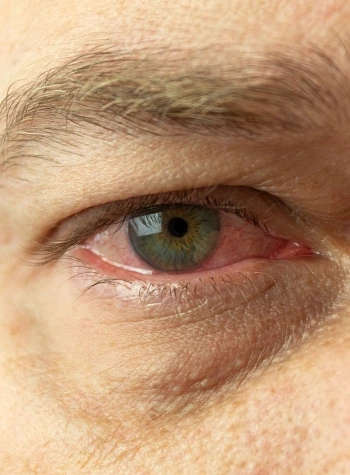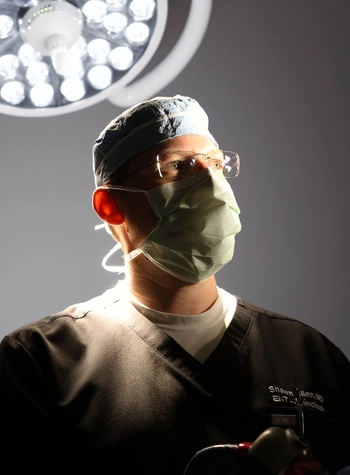Dr. Shawn Allen has either authored or reviewed and approved this content.
Page Updated:Breathe better, sleep better, feel better!
Persistent watery eyes (epiphora) can be frustrating and may even interfere with a person’s ability to engage in normal daily
Trusted Source
Impact of epiphora on vision-related quality of life
Shin JH, Kim YD, Woo KI; Korean Society of Ophthalmic Plastic and Reconstructive Surgery (KSOPRS)
Go to Source
activities.
Dr. Shawn Allen is a Board-Certified Otolaryngologist (ENT) and fellowship-trained Rhinologist specializing in the diagnosis and treatment of nasal and sinus conditions, and can help patients in Houston and The Woodlands, Texas find relief from watery eyes.

Epiphora is the medical name for chronically or excessively watery eyes. In many cases, watery eyes are an occasionally frustrating issue that resolves on its own. However, chronic epiphora often requires treatment by an experienced sinus specialist.
Persistent tearing is the result of excess tear production or poor tear drainage, and may be caused by a number of factors.
Common causes of excess tear production and temporary watery eyes include allergies, fatigue, eye strain, and foreign bodies in the eye. When this is the case, watery eyes often resolve on their own or may be treated with over-the-counter eye drops or artificial tears.
Watery eyes that are caused by inadequate tear drainage due to a blockage in the tear duct drainage system or other issues in the nasolacrimal system often require specialized treatment. More serious conditions that may contribute to excessive tearing include:
Irritation from an eye infection such as conjunctivitis (pink eye) can cause watery eyes.
Trichiasis is a somewhat common cause of watery eyes, and is a result of irritation caused by eyelashes that grow inwards. In this case, an ophthalmologist can remove in-grown eyelashes.
Ectropion is a condition that causes the lower eyelids to turn away from the eye, while entropion causes the eyelids to turn inward. These conditions can lead to irritation and excessive tearing. Ectropion and entropion is surgically treated by an ophthalmologist and involves tightening the tendon that holds the eyelid in position.
Dacryocystitis is a recurring infection of the lacrimal sac. First line treatment of this condition involves flushing the lacrimal sac and nasolacrimal duct along with antibiotics. If this treatment is not effective, a surgical procedure called dacryocystorhinostomy (DCR) may be performed.
Significant swelling of the lower turbinates may obstruct the valve that drains tears into the nose, resulting in epiphora until the nasal swelling resolves. Nasal polyp patients more often experience this degree of nasal obstruction leading to epiphora. Identifying and treating such nasal conditions may relieve epiphora entirely.

Significant swelling of the lower turbinates may obstruct the valve that drains tears into the nose, resulting in epiphora until the nasal swelling resolves. Nasal polyp patients more often experience this degree of nasal obstruction leading to epiphora. Identifying and treating such nasal conditions may relieve epiphora entirely.
When watery eyes become persistent or chronic, it is time to contact a specialist. Dr. Allen’s first step in treating epiphora is to diagnose the underlying cause of the issue through nasal endoscopy and CT Imaging, which help determine if common nasal conditions are potentially to blame. Referral to an Ophthalmologist may also be recommended if nasal causes of lacrimal obstruction alone do not explain the abnormal flow of tears.
When nasal endoscopy and additional diagnostic tests reveal inadequate drainage of the lacrimal duct system due to nasolacrimal duct obstruction, Dr. Allen may perform an endoscopic dacryocystorhinostomy (DCR) . During this procedure involving general anesthesia, Dr. Allen uses an endoscope and small surgical tools to remove bone over the lacrimal sac and opens it widely into the nose, restoring the drainage of tears into the nasal
Trusted Source
Dacryocystorhinostomy: treatment for a blocked tear duct
Johns Hopkins Medicine
Go to Source
cavity.

As a nose and sinus specialist, Dr. Allen is experienced in diagnosing and treating epiphora. If you live in Houston or The Woodlands, Texas and experience chronic watery eyes, contact Dr. Allen to schedule a consultation.
1 Shin JH, Kim YD, Woo KI; Korean Society of Ophthalmic Plastic and Reconstructive Surgery (KSOPRS). Impact of epiphora on vision-related quality of life. BMC Ophthalmol. 2015 Jan 21;15:6. doi: 10.1186/1471-2415-15-6. PMID: 25613683; PMCID: PMC4320496. Available: https://pubmed.ncbi.nlm.nih.gov/25613683/. Accessed March 1, 2023.
2 Johns Hopkins Medicine. Dacryocystorhinostomy: treatment for a blocked tear duct. Available: https://www.hopkinsmedicine.org/health/conditions-and-diseases/dacryocystorhinostomy. Accessed March 1, 2023.
Dr. Shawn Allen has either authored or reviewed and approved this content.
Page Updated: